Abstract
A dissimilatory Fe(III)- and Mn(IV)-reducing microorganism was isolated from freshwater sediments of the Potomac River, Maryland. The isolate, designated GS-15, grew in defined anaerobic medium with acetate as the sole electron donor and Fe(III), Mn(IV), or nitrate as the sole electron acceptor. GS-15 oxidized acetate to carbon dioxide with the concomitant reduction of amorphic Fe(III) oxide to magnetite (Fe3O4). When Fe(III) citrate replaced amorphic Fe(III) oxide as the electron acceptor, GS-15 grew faster and reduced all of the added Fe(III) to Fe(II). GS-15 reduced a natural amorphic Fe(III) oxide but did not significantly reduce highly crystalline Fe(III) forms. Fe(III) was reduced optimally at pH 6.7 to 7 and at 30 to 35°C. Ethanol, butyrate, and propionate could also serve as electron donors for Fe(III) reduction. A variety of other organic compounds and hydrogen could not. MnO2 was completely reduced to Mn(II), which precipitated as rhodochrosite (MnCO3). Nitrate was reduced to ammonia. Oxygen could not serve as an electron acceptor, and it inhibited growth with the other electron acceptors. This is the first demonstration that microorganisms can completely oxidize organic compounds with Fe(III) or Mn(IV) as the sole electron acceptor and that oxidation of organic matter coupled to dissimilatory Fe(III) or Mn(IV) reduction can yield energy for microbial growth. GS-15 provides a model for how enzymatically catalyzed reactions can be quantitatively significant mechanisms for the reduction of iron and manganese in anaerobic environments.
Full text
PDF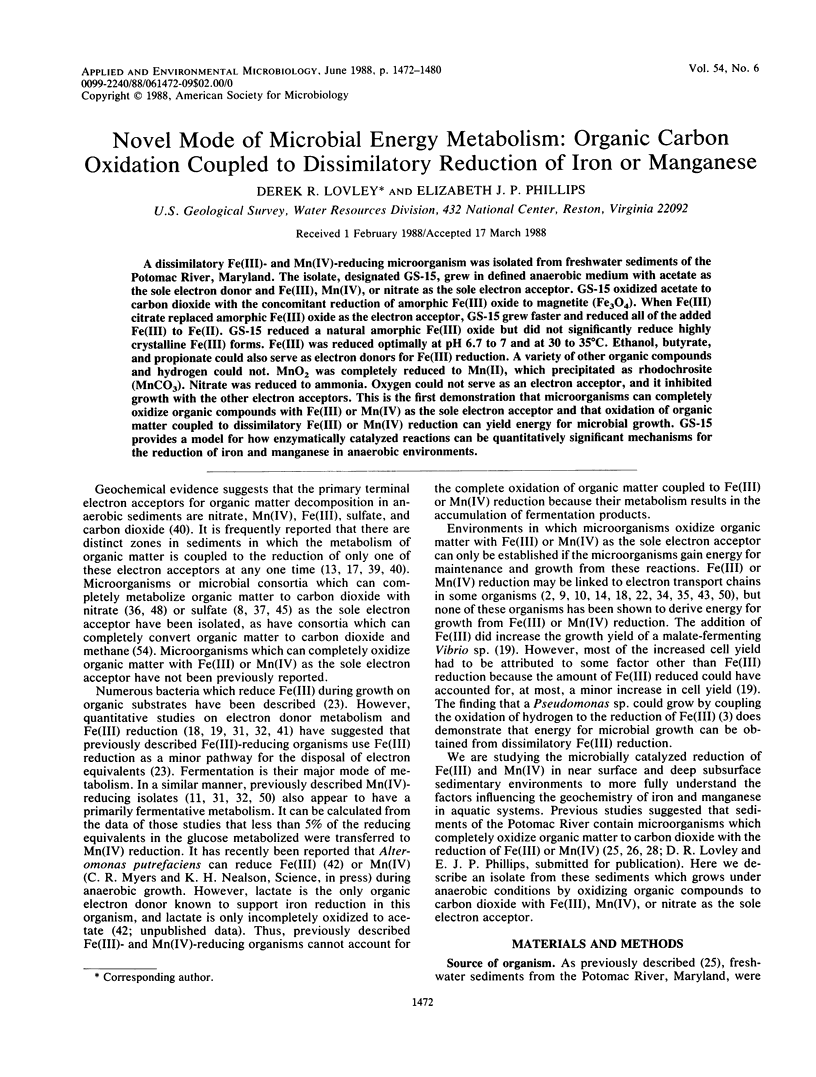
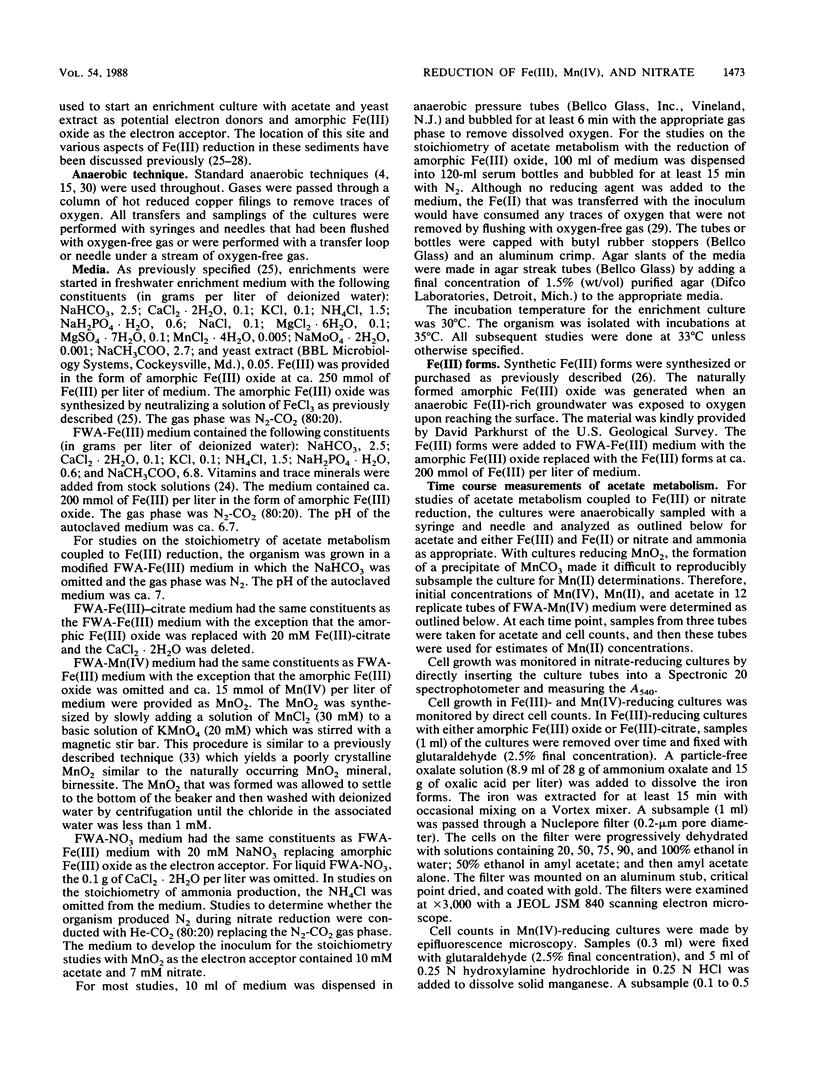
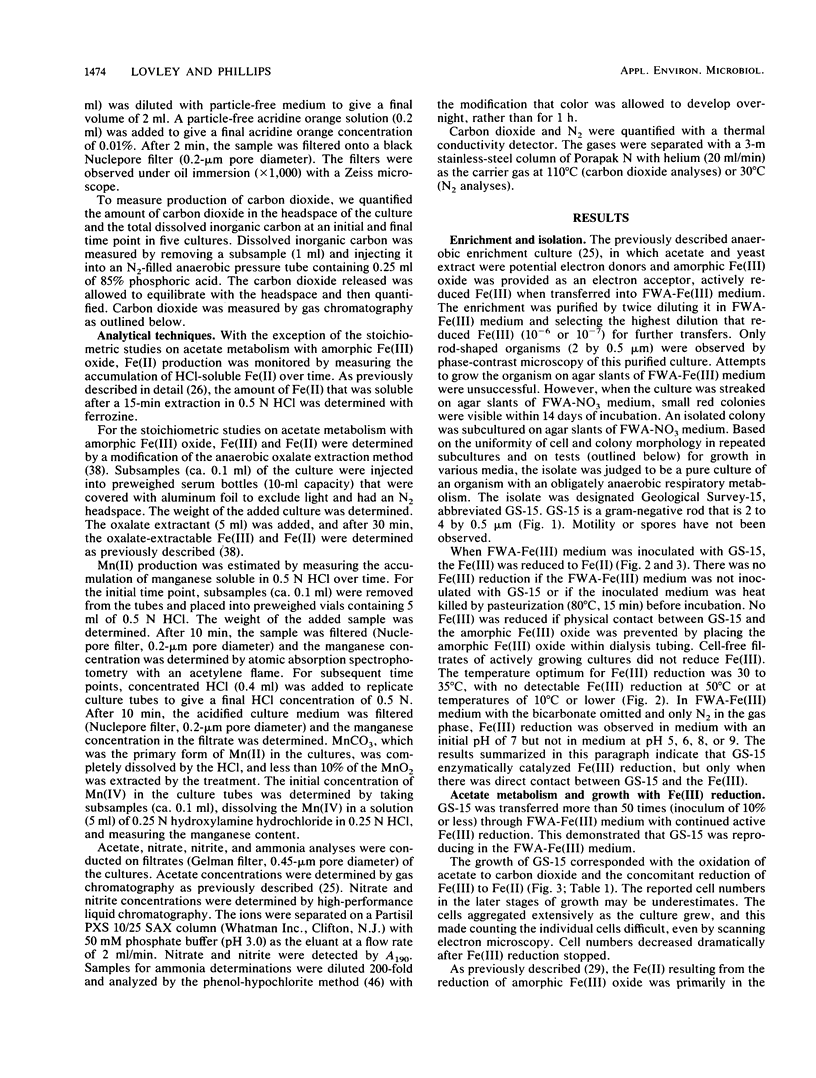
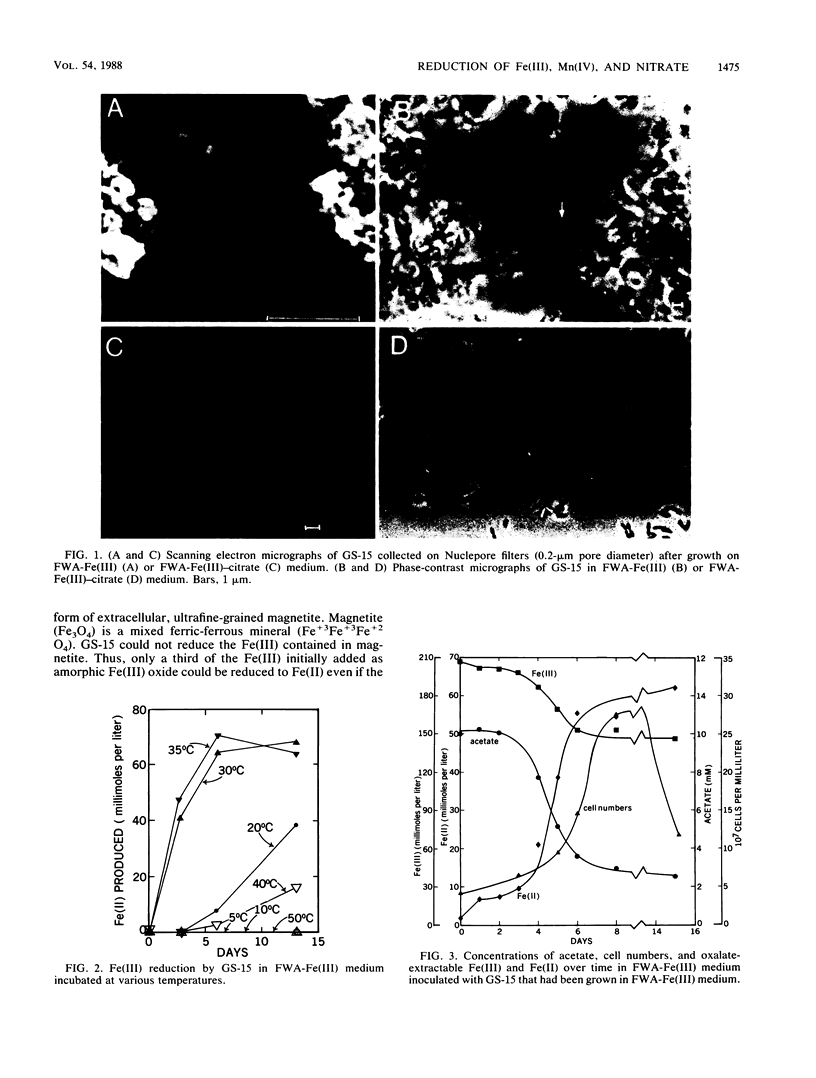
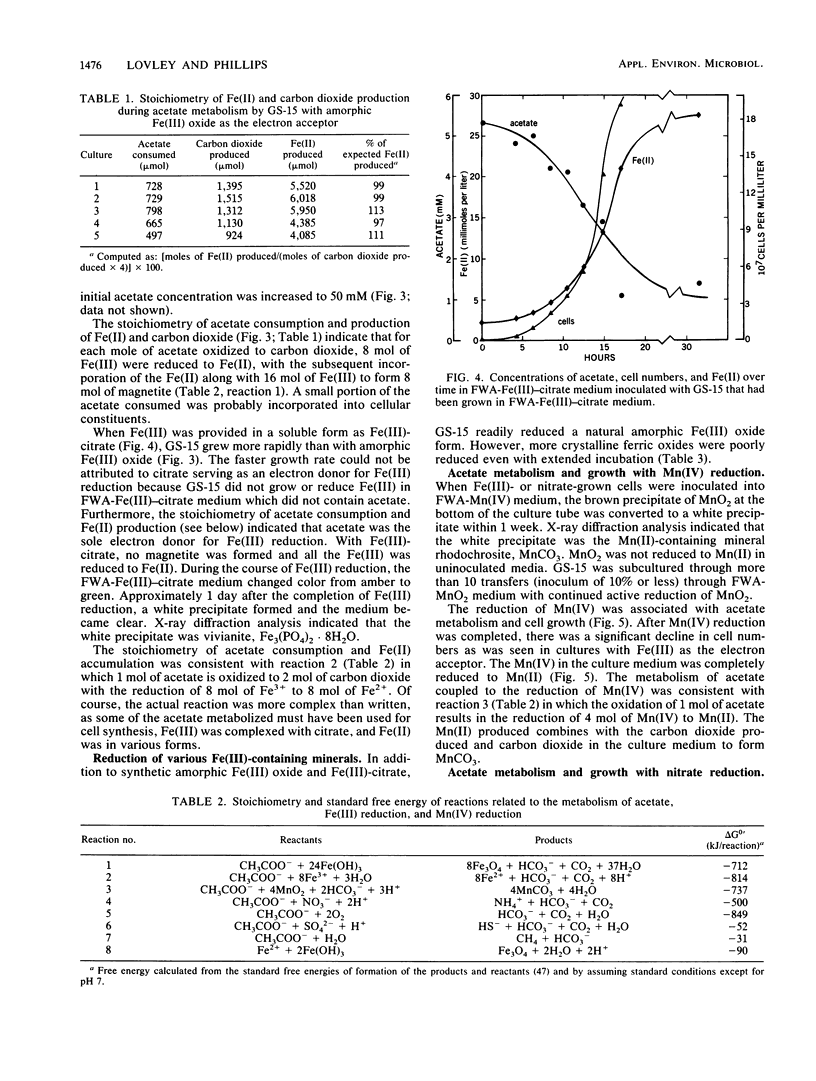
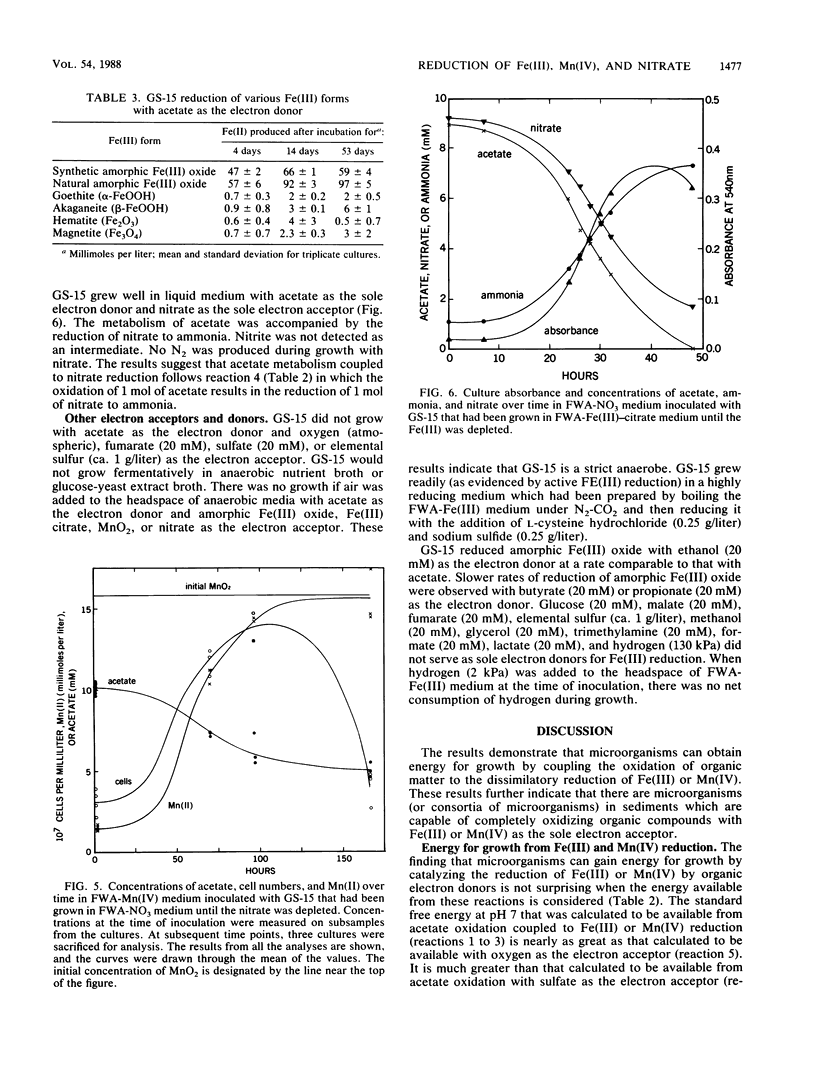
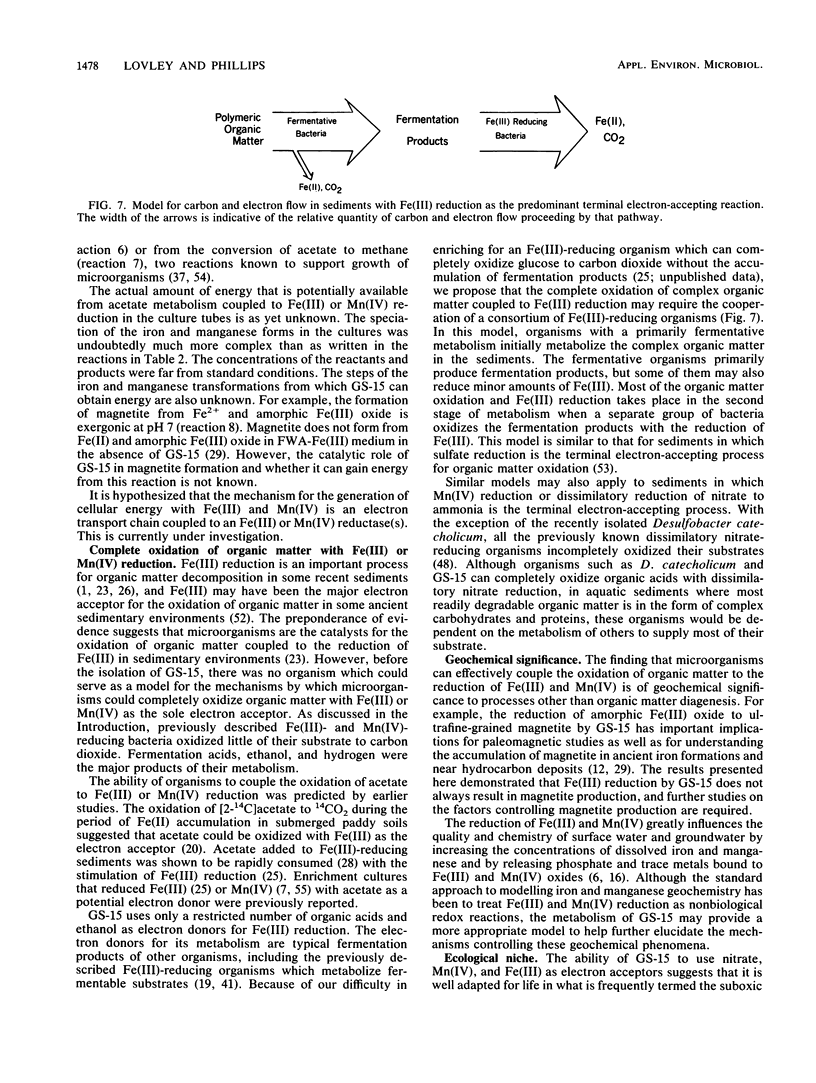

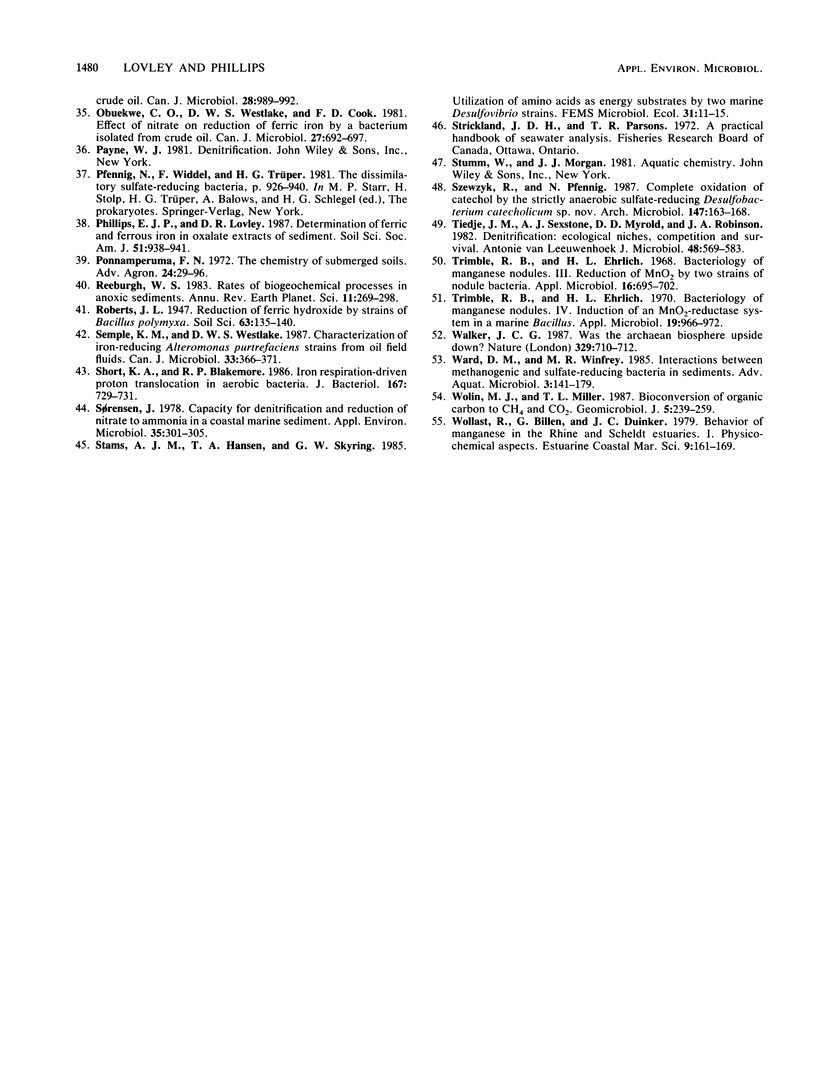
Images in this article
Selected References
These references are in PubMed. This may not be the complete list of references from this article.
- Arnold R. G., DiChristina T. J., Hoffmann M. R. Inhibitor studies of dissimilative Fe(III) reduction by Pseudomonas sp. strain 200 ("Pseudomonas ferrireductans") Appl Environ Microbiol. 1986 Aug;52(2):281–289. doi: 10.1128/aem.52.2.281-289.1986. [DOI] [PMC free article] [PubMed] [Google Scholar]
- Balch W. E., Fox G. E., Magrum L. J., Woese C. R., Wolfe R. S. Methanogens: reevaluation of a unique biological group. Microbiol Rev. 1979 Jun;43(2):260–296. doi: 10.1128/mr.43.2.260-296.1979. [DOI] [PMC free article] [PubMed] [Google Scholar]
- Burdige D. J., Nealson K. H. Microbial manganese reduction by enrichment cultures from coastal marine sediments. Appl Environ Microbiol. 1985 Aug;50(2):491–497. doi: 10.1128/aem.50.2.491-497.1985. [DOI] [PMC free article] [PubMed] [Google Scholar]
- Dailey H. A., Jr, Lascelles J. Reduction of iron and synthesis of protoheme by Spirillum itersonii and other organisms. J Bacteriol. 1977 Feb;129(2):815–820. doi: 10.1128/jb.129.2.815-820.1977. [DOI] [PMC free article] [PubMed] [Google Scholar]
- Ghiorse W. C., Ehrlich H. L. Electron transport components of the MnO2 reductase system and the location of the terminal reductase in a marine Bacillus. Appl Environ Microbiol. 1976 Jun;31(6):977–985. doi: 10.1128/aem.31.6.977-985.1976. [DOI] [PMC free article] [PubMed] [Google Scholar]
- Lascelles J., Burke K. A. Reduction of ferric iron by L-lactate and DL-glycerol-3-phosphate in membrane preparations from Staphylococcus aureus and interactions with the nitrate reductase system. J Bacteriol. 1978 May;134(2):585–589. doi: 10.1128/jb.134.2.585-589.1978. [DOI] [PMC free article] [PubMed] [Google Scholar]
- Lovley D. R., Greening R. C., Ferry J. G. Rapidly growing rumen methanogenic organism that synthesizes coenzyme M and has a high affinity for formate. Appl Environ Microbiol. 1984 Jul;48(1):81–87. doi: 10.1128/aem.48.1.81-87.1984. [DOI] [PMC free article] [PubMed] [Google Scholar]
- Lovley D. R., Phillips E. J. Availability of ferric iron for microbial reduction in bottom sediments of the freshwater tidal potomac river. Appl Environ Microbiol. 1986 Oct;52(4):751–757. doi: 10.1128/aem.52.4.751-757.1986. [DOI] [PMC free article] [PubMed] [Google Scholar]
- Lovley D. R., Phillips E. J. Competitive mechanisms for inhibition of sulfate reduction and methane production in the zone of ferric iron reduction in sediments. Appl Environ Microbiol. 1987 Nov;53(11):2636–2641. doi: 10.1128/aem.53.11.2636-2641.1987. [DOI] [PMC free article] [PubMed] [Google Scholar]
- Lovley D. R., Phillips E. J. Organic matter mineralization with reduction of ferric iron in anaerobic sediments. Appl Environ Microbiol. 1986 Apr;51(4):683–689. doi: 10.1128/aem.51.4.683-689.1986. [DOI] [PMC free article] [PubMed] [Google Scholar]
- Lovley D. R., Phillips E. J. Rapid assay for microbially reducible ferric iron in aquatic sediments. Appl Environ Microbiol. 1987 Jul;53(7):1536–1540. doi: 10.1128/aem.53.7.1536-1540.1987. [DOI] [PMC free article] [PubMed] [Google Scholar]
- Miller T. L., Wolin M. J. A serum bottle modification of the Hungate technique for cultivating obligate anaerobes. Appl Microbiol. 1974 May;27(5):985–987. doi: 10.1128/am.27.5.985-987.1974. [DOI] [PMC free article] [PubMed] [Google Scholar]
- Obuekwe C. O., Westlake D. W., Cook F. D. Effect of nitrate on reduction of ferric iron by a bacterium isolated from crude oil. Can J Microbiol. 1981 Jul;27(7):692–697. doi: 10.1139/m81-107. [DOI] [PubMed] [Google Scholar]
- Short K. A., Blakemore R. P. Iron respiration-driven proton translocation in aerobic bacteria. J Bacteriol. 1986 Aug;167(2):729–731. doi: 10.1128/jb.167.2.729-731.1986. [DOI] [PMC free article] [PubMed] [Google Scholar]
- Sørensen J. Capacity for denitrification and reduction of nitrate to ammonia in a coastal marine sediment. Appl Environ Microbiol. 1978 Feb;35(2):301–305. doi: 10.1128/aem.35.2.301-305.1978. [DOI] [PMC free article] [PubMed] [Google Scholar]
- Tiedje J. M., Sexstone A. J., Myrold D. D., Robinson J. A. Denitrification: ecological niches, competition and survival. Antonie Van Leeuwenhoek. 1982;48(6):569–583. doi: 10.1007/BF00399542. [DOI] [PubMed] [Google Scholar]
- Trimble R. B., Ehrlich H. L. Bacteriology of manganese nodules. IV. Induction of an MnO2-reductase system in a marine bacillus. Appl Microbiol. 1970 Jun;19(6):966–972. doi: 10.1128/am.19.6.966-972.1970. [DOI] [PMC free article] [PubMed] [Google Scholar]
- Trimble R. B., Ehrlich H. L. Bacteriology of manganese nodules: III. Reduction of MnO(2) by two strains of nodule bacteria. Appl Microbiol. 1968 May;16(5):695–702. doi: 10.1128/am.16.5.695-702.1968. [DOI] [PMC free article] [PubMed] [Google Scholar]
- Walker J. C. Was the Archaean biosphere upside down? Nature. 1987 Oct 22;329:710–712. doi: 10.1038/329710a0. [DOI] [PubMed] [Google Scholar]
- de Vrind J. P., Boogerd F. C., de Vrind-de Jong E. W. Manganese reduction by a marine Bacillus species. J Bacteriol. 1986 Jul;167(1):30–34. doi: 10.1128/jb.167.1.30-34.1986. [DOI] [PMC free article] [PubMed] [Google Scholar]



